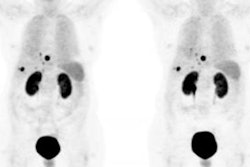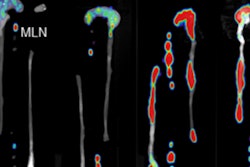
A new PET imaging radiotracer may help advance the understanding of neurodegenerative disease and the aging brain, according to research published in the October issue of the Journal of Nuclear Medicine.
The research from Johns Hopkins University focused on the reduced density of the α4β2 nicotinic acetylcholine receptor (α4β2-nAChR) in the cortex and hippocampus brain regions of older patients and individuals with neurodegenerative disease. This receptor is partly responsible for learning, and a small loss of function can decrease neurotransmission across neural circuits.
The researchers, led by Dr. Jennifer Coughlin, an assistant professor of psychiatry and behavioral sciences, evaluated the pharmacokinetic behavior of the radiotracer F-18 XTRA on the α4β2-nAChR receptor in 17 adults.
They found high uptake of F-18 XTRA in the brain, rapid pharmacokinetics, and an ability to estimate binding in extrathalamic regions within a 90-minute PET scan, according to the Society of Nuclear Medicine and Molecular Imaging (SNMMI). In addition, there was less binding of F-18 XTRA in the hippocampus with healthy aging (JNM, October 2018, Vol. 59:10, pp. 1603-1608).
"Together, our results suggest that [F-18 XTRA PET] may be sufficiently sensitive to measure the hypothesized loss of α4β2-nAChR availability over aging, particularly in the hippocampus," senior author Dr. Martin Pomper, PhD, said in an SNMMI statement. "This is a promising tool for the future study of changed cholinergic signaling in the brain over healthy aging that may be linked to changes in memory over the lifespan."
The researchers believe their findings will be important for future studies, especially in regard to monitoring and assessing neurodegenerative and age-related changes in the human brain.




















